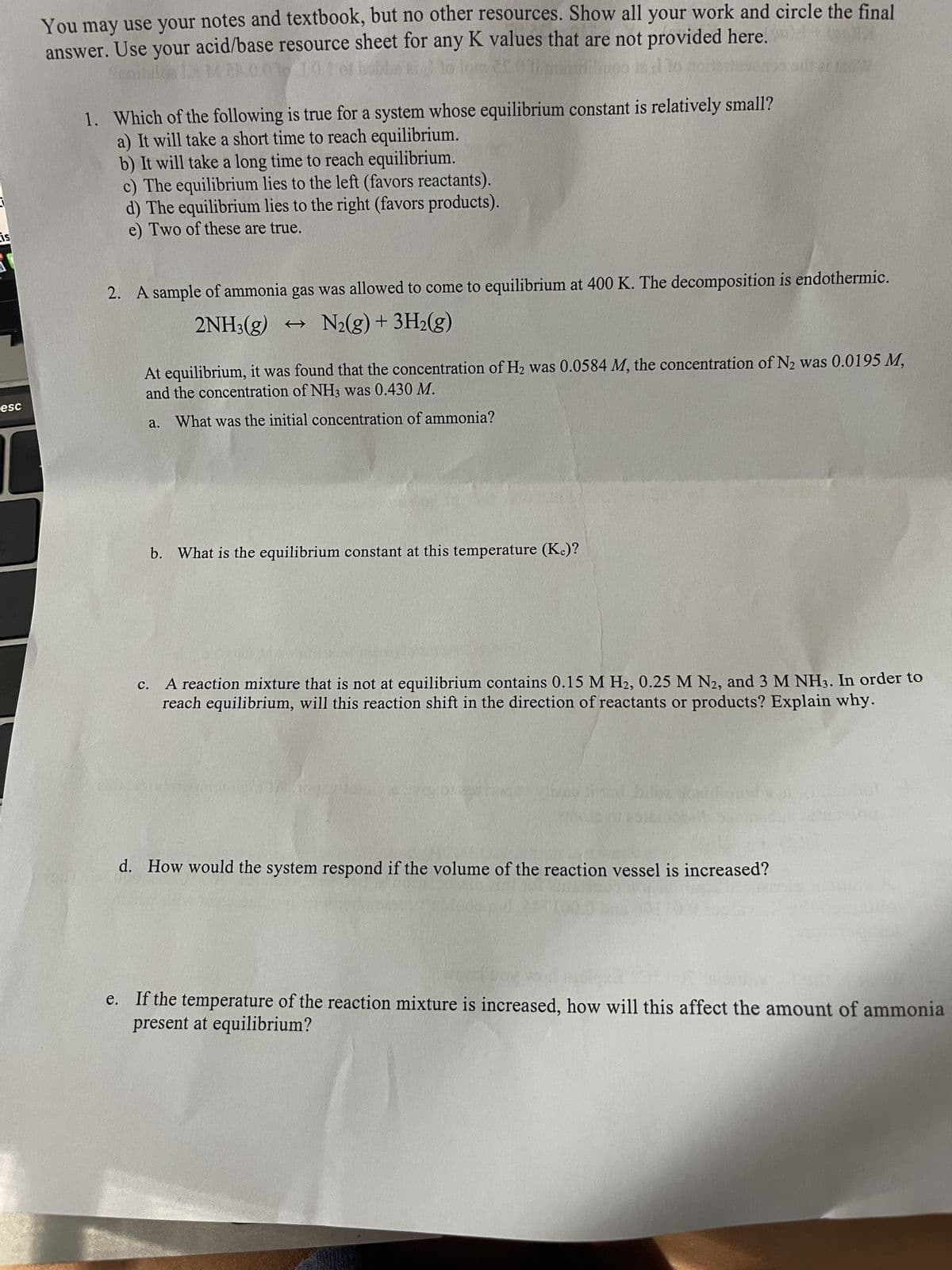1. Which of the following is true for a system whose equilibrium constant is relatively small? a) It will take a short time to reach equilibrium. b) It will take a long time to reach equilibrium. c) The equilibrium lies to the left (favors reactants). d) The equilibrium lies to the right (favors products). e) Two of these are true.
1. Which of the following is true for a system whose equilibrium constant is relatively small? a) It will take a short time to reach equilibrium. b) It will take a long time to reach equilibrium. c) The equilibrium lies to the left (favors reactants). d) The equilibrium lies to the right (favors products). e) Two of these are true.
Introductory Chemistry: A Foundation
9th Edition
ISBN:9781337399425
Author:Steven S. Zumdahl, Donald J. DeCoste
Publisher:Steven S. Zumdahl, Donald J. DeCoste
Chapter16: Acids And Bases
Section: Chapter Questions
Problem 65AP: . The concepts of acid-base equilibria were developed in this chapter for aqueous solutions (in...
Related questions
Question
#1 please

Transcribed Image Text:is
esc
You may use your notes and textbook, but no other resources. Show all your work and circle the final
answer. Use your acid/base resource sheet for any K values that are not provided here.
(2
JEGYZ
bubb
1. Which of the following is true for a system whose equilibrium constant is relatively small?
a) It will take a short time to reach equilibrium.
b) It will take a long time to reach equilibrium.
c) The equilibrium lies to the left (favors reactants).
d) The equilibrium lies to the right (favors products).
e) Two of these are true.
2.
sample of ammonia gas was allowed to come to equilibrium at 400 K. The decomposition is endothermic.
2NH3(g) → N₂(g) + 3H₂(g)
At equilibrium, it was found that the concentration of H₂ was 0.0584 M, the concentration of N₂ was 0.0195 M,
and the concentration of NH3 was 0.430 M.
What was the initial concentration of ammonia?
b. What is the equilibrium constant at this temperature (K.)?
C.
A reaction mixture that is not at equilibrium contains 0.15 M H2, 0.25 M N2, and 3 M NH3. In order to
reach equilibrium, will this reaction shift in the direction of reactants or products? Explain why.
g of a nagy
d. How would the system respond if the volume of the reaction vessel is increased?
e. If the temperature of the reaction mixture is increased, how will this affect the amount of ammonia
present at equilibrium?
Expert Solution
This question has been solved!
Explore an expertly crafted, step-by-step solution for a thorough understanding of key concepts.
This is a popular solution!
Trending now
This is a popular solution!
Step by step
Solved in 2 steps

Knowledge Booster
Learn more about
Need a deep-dive on the concept behind this application? Look no further. Learn more about this topic, chemistry and related others by exploring similar questions and additional content below.Recommended textbooks for you

Introductory Chemistry: A Foundation
Chemistry
ISBN:
9781337399425
Author:
Steven S. Zumdahl, Donald J. DeCoste
Publisher:
Cengage Learning

Chemistry & Chemical Reactivity
Chemistry
ISBN:
9781337399074
Author:
John C. Kotz, Paul M. Treichel, John Townsend, David Treichel
Publisher:
Cengage Learning

Chemistry & Chemical Reactivity
Chemistry
ISBN:
9781133949640
Author:
John C. Kotz, Paul M. Treichel, John Townsend, David Treichel
Publisher:
Cengage Learning

Introductory Chemistry: A Foundation
Chemistry
ISBN:
9781337399425
Author:
Steven S. Zumdahl, Donald J. DeCoste
Publisher:
Cengage Learning

Chemistry & Chemical Reactivity
Chemistry
ISBN:
9781337399074
Author:
John C. Kotz, Paul M. Treichel, John Townsend, David Treichel
Publisher:
Cengage Learning

Chemistry & Chemical Reactivity
Chemistry
ISBN:
9781133949640
Author:
John C. Kotz, Paul M. Treichel, John Townsend, David Treichel
Publisher:
Cengage Learning

Chemistry: Principles and Reactions
Chemistry
ISBN:
9781305079373
Author:
William L. Masterton, Cecile N. Hurley
Publisher:
Cengage Learning


Chemistry
Chemistry
ISBN:
9781305957404
Author:
Steven S. Zumdahl, Susan A. Zumdahl, Donald J. DeCoste
Publisher:
Cengage Learning